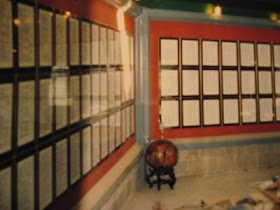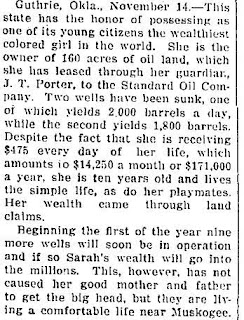In 1993 I had the opportunity to visit a gentleman I had heard about in a Black History Video about the Freedmen of Indian Territory. An elder gentleman, descendant of Creek Freedmen was interested in representing his history and his own family ties to the Muskogee Creek Freedmen.
His name was Napoleon Davis of Taft Oklahoma. He lived on his property in Taft and had for many years wanted to created a shrine honoring his ancestors, the Creek Freedmen. In 1990 Mr. Davis was interviewed by a Washington DC journalist, who is also a Cherokee Freedmen. In that particular documentary, the history of the people enslaved in Indian Territory was featured. The documentary ended with the words of Mr. Davis who was at that time constructing his shrine to the Creek Freedmen. His goal, he stated was to honor them and thereby perhaps representing something that his ancestors may have wanted to say, but could not say.
Two years later, on a visit to Oklahoma, I gave a presentation at the Rudisill Library in Tulsa Oklahoma. A woman was there, who lived in Checotah, and I mentioned that I had heard about the shrine being built, and she immediately pointed out that Mr. Davis was her cousin. She offered to take me there, which I shall be forever grateful. A few days later, we met at her home in Checotah, and off we went to Taft, to visit the site.
Approaching his property across the fields one can see the structure. Not until one gets to the site, can one see the marble walls that announce what the structure actually is.
A round almost cone shaped roots stands in the middle of the property with flag at the entrance. As the driveway goes to the front of the building the actual shape can be seen.
As I walked toward the entrance after parking the wall and the words enscribed on them were clear.
A another marbel panel bears the names of members of his family engraved in each star.
A large portion of the wall remained blank, which he later explained would be the formal name of the site after a dedication that he hoped to someday have with state political figures to attend.
Mr. Davis greeted me in front of the shrine and graciously allowed me to take photos and explained the symbolism behind what he had done. His goal was to honor the Creek Freedmen, and to honor them as African American people with strong ties to their land as Creek citizens. He had a very strong feeling about the images that many persons of African Ancestry had, and how they are often depicted and perceived, and he wanted very much to have the site dedicated as an African American site.
The most remarkable aspect about the facility was the inside. He wanted to honor the ancestors, and honoring them, he did!
On the inside, for what greeted any visitor to the sites were the names---several thousands names---of his ancestors and the people with whom his ancestors identified. The Creek Freedmen. The names of all of them were on the wall, on more than 120 laminated plaques and afixed to the wall of the site. Thousands of
names of Creek Freedmen that were on the Final Dawes Rolls. The pages were names that appeared on Campbell's Abstract.
Two Views Inside of the Creek Freedmen Shrine
Mr. Davis then sat down and spoke to me about his goals and how he hoped that others would appreciate what he had done. His hope was to someday have an official opening and dedication ceremony at the site, and that others would travel to pay honor to the history of the Creek Freedmen.

I visited him again in 1994, and he was still hoping to launch an opening, but had not been supported by many in the local area. Unfortunately, Mr. Napoleon Davis passed away from complications during a surgical procedure. It has been now about 10 years since his death. Though spoken about frequently, it is not known if there has been any activity expressed to continue what was begun by Mr. Davis, or to preserve what he built.
The Shrine is located on the Davis estate in Taft Oklahoma. Hopefully what was built will not fall into ruin.













































